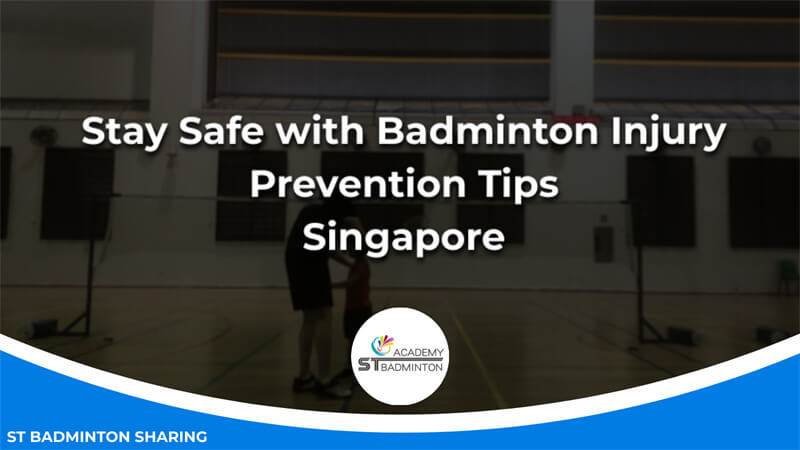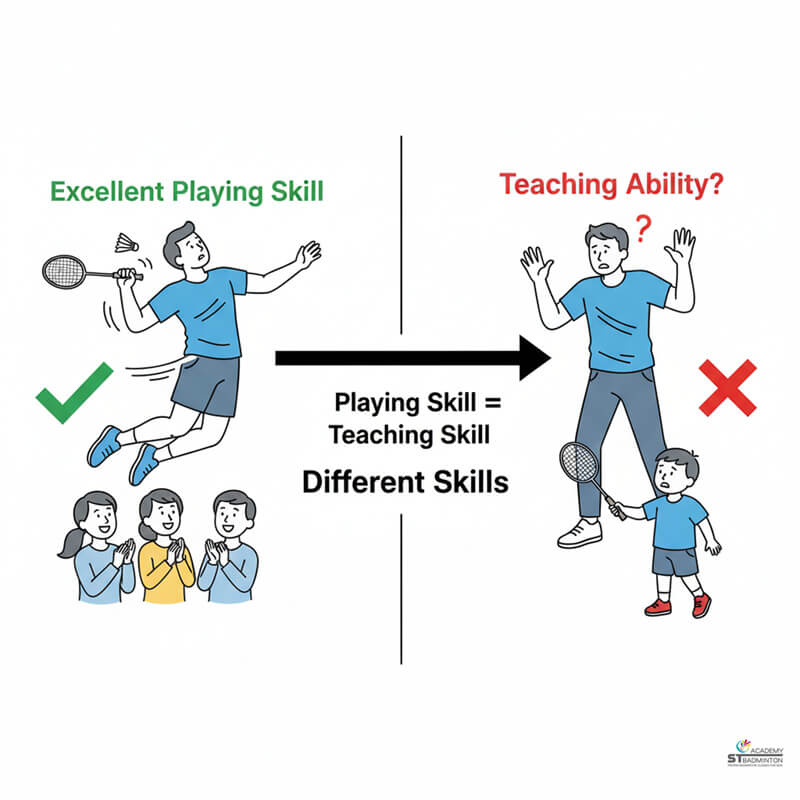Welcome to the ST Badminton Academy in Malaysia! Badminton is an incredible game that helps in improving physical fitness, hand-eye coordination, and reflexes. However, it can also be dangerous if the necessary precautions are not taken. Injuries such as sprains, strains, and fractures can occur during gameplay which may result in long-term consequences.
Therefore, it’s essential to know how to prevent injuries while playing badminton. Whether you’re a beginner or an advanced player, there are several injury prevention tips that can help keep you safe on the court.
This article will provide some valuable insights into the best practices for staying healthy and avoiding common injuries related to badminton. So let’s dive in!
Benefits Of Playing Badminton in Malaysia
Playing badminton is like spreading your wings and soaring through the sky. It gives you an exhilarating feeling of freedom and control over your body while providing numerous benefits to both physical and mental health.
One of the most significant advantages of playing badminton is its aerobic benefits, which help improve cardiovascular health by increasing heart rate and oxygen intake. Moreover, it also helps in building physical strength as it requires a lot of movement involving arms, legs, and core muscles.
Playing badminton also enhances mental focus as one needs to be attentive throughout the game, anticipating their opponent’s moves while planning their own strategies. The sport can also act as a stress relief activity that allows individuals to take time off from their busy schedule and unwind by engaging in a fun-filled sessions with friends or family members.
Additionally, consistent practice improves reflexes, thus enhancing an individual’s overall agility and coordination skills without even realizing it. Playing badminton has benefited many people beyond just fitness enthusiasts; it could potentially benefit anyone who wants to lead a healthy lifestyle while having fun at the same time!
Types Of Badminton Injuries
After learning the various benefits of playing badminton, it’s important to take note that injuries can still happen.
Types of badminton injuries include shoulder pain, wrist sprains, and ankle strains.
In order to prevent these injuries from occurring, there are several steps you can take.
Firstly, correct technique and posture are essential in reducing your risk for injury. This means ensuring that your form is proper when hitting the shuttlecock and maintaining a good stance throughout the game.
Additionally, incorporating regular stretching into your routine will help keep your muscles limber and decrease the chances of strain or sprain. Proper nutrition and adequate rest also play an important role in keeping you healthy on the court.
Incorporating these strategies into your routine not only helps prevent injury but also improves overall performance while playing badminton.
By taking care of your body through correct technique, posture, nutrition, stretching, and rest you’ll be able to enjoy all the great benefits of this sport without having to worry about unnecessary setbacks caused by injuries.
Essential Equipment For Injury Prevention
As a badminton player, you want to stay safe on the court. However, it’s ironic that the same equipment designed for playing can also cause injuries if not chosen wisely. That’s why it’s crucial to select essential equipment that prevents injury and enhances your performance.
Playing surfaces should be chosen carefully as they directly affect players’ safety. Hardwood or synthetic flooring is ideal as it provides optimal shock absorption while minimizing slipping hazards.
Moreover, racket design plays an important role in preventing wrist and shoulder injuries by distributing weight effectively across the frame. Other than a racket, also remember to choose the best badminton resting in Malaysia. Always choose one with a comfortable grip and appropriate tension according to your skill level.
Additionally, consider risk factors like age, physical fitness, and previous injuries when choosing protective gear such as ankle braces or knee pads.
Body mechanics are equally important in injury prevention; therefore, investing time in proper form will pay off during gameplay. Warm-up exercises followed by stretching routines before matches help increase flexibility while reducing muscle stiffness and soreness post-game.
Remember that essential equipment is more than just tools for play – they’re investments in your health and performance potential!
Warm Up And Cool Down Exercises
According to our badminton coach, to prevent badminton injuries, it is essential to warm up before any physical activity. Warming up helps increase blood flow and body temperature, which prepares your muscles for more intense movements.
Proper stretching techniques are essential during the warm-up phase as they help improve flexibility and reduce muscle stiffness.
Flexibility training can also aid in injury prevention by increasing joint mobility and reducing the risk of strains or sprains.
Incorporating restorative exercises into your routine can further enhance recovery time between games and practices.
Additionally, proper footwear selection that supports your feet and promotes good body alignment can play a critical role in preventing common badminton-related foot injuries like plantar fasciitis.
To summarize, warming up with stretching techniques, incorporating flexibility training and restorative exercises into your routine, selecting suitable footwear that supports your feet while promoting correct body alignment are crucial steps towards preventing badminton injuries.
Remember to prioritize injury prevention measures to keep yourself safe on the court so you can enjoy playing badminton without worry!
Strategies To Avoid Injury
To avoid injuries while playing badminton, it is essential to follow some strategies.
Firstly, the proper technique should be maintained while playing the game. This includes correct body positioning and footwork to prevent overstretching or twisting of muscles.
Stretching regularly before and after the game also helps in preventing muscle strains and sprains.
Proper nutrition and hydration habits are equally important to keep your body fit for the game.
Adequate rest intervals between games can help prevent fatigue-associated injuries like cramps or muscle pulls.
Incorporating these injury prevention tips into your badminton routine will not only help you stay safe but also improve your overall performance on the court.
Remember, taking care of your body off the court is just as crucial as practicing on the court.
Advice For Playing In Different Conditions
When playing badminton, it’s important to take steps to avoid injury. Now that we’ve discussed some strategies for staying safe on the court, let’s talk about how different conditions can affect your game and what you can do to adapt.
Indoor and outdoor environments each come with their own set of challenges. When playing indoors, you’ll likely encounter a controlled climate with consistent lighting and surface conditions. Conversely, the outdoor play exposes you to natural elements like wind, sun exposure, and temperature fluctuations.
Here’s a table outlining some common environmental factors in badminton:
Certainly! Here’s the information organized into a table:
| Condition | Effect |
|---|---|
| Wet Surface | Increases risk of slipping or falling |
| Dry Surface | May cause joint pain from increased impact |
| High Temperature | Can lead to dehydration and overheating |
| Low Temperature | Increases risk of muscle strains or tears |
| Windy Conditions | Affects shuttlecock trajectory and requires extra effort to maintain control |
| Calm Conditions | Shuttlecock may be easier to hit accurately |
Feel free to adjust the formatting as needed.
By being aware of these factors and adjusting your gameplay accordingly (such as wearing sunscreen during sunny matches or adding layers when it’s cold), you can minimize your risk of injury while still enjoying the sport.
Remember to always stay hydrated and listen to your body – if something feels off, don’t hesitate to take a break or seek medical attention.
Injury Treatments
If you experience pain or discomfort while playing badminton, it’s important to seek treatment right away.
Preventing pain and rehabilitating muscles are key components of injury treatment.
To prevent further damage, stretching techniques can be used to improve flexibility and reduce tension in your muscles.
Additionally, proper body mechanics during gameplay can help avoid future injuries.
Another factor that plays a significant role in injury prevention is proper nutrition.
Eating a balanced diet with the necessary vitamins and minerals will keep your bones strong and aid in muscle recovery.
When dealing with an injury, rehabilitation exercises may be prescribed by a medical professional.
These exercises are designed to strengthen weakened muscles and increase mobility.
It’s important to follow these routines diligently for optimal results.
Overall, taking care of your body both on and off the court is crucial for staying safe while playing badminton.
By incorporating these tips into your routine, you’ll not only enhance your performance but also minimize the risk of experiencing future injuries.
When To Seek Professional Help
It’s important to know when to seek professional help for badminton injuries.
While avoiding triggers and practicing stretching techniques can help prevent injury, it’s also crucial to use the correct technique during gameplay and listen to your body if you feel any discomfort or pain.
If you experience persistent pain or notice that an injury is not healing properly, seeking professional advice from a sports medicine doctor or physical therapist may be necessary.
These professionals can provide personalized treatment plans and rehabilitation exercises to help you recover safely and effectively.
Remember, taking care of your body should always come first in order for you to continue enjoying the sport of badminton without risking further harm.
Tips For Returning To The Court
After seeking professional help, it’s important to ease back into the game with caution. Just like a bird stretching its wings before taking flight, players must prepare their bodies and minds for the court.
As you gear up for practice or competition, keep these tips in mind:
Stretching Techniques
- Warm-up with dynamic stretches
- Focus on areas prone to injury
Proper Footwear
- Choose shoes that fit well and provide ample support
- Avoid playing in old or worn-out shoes
Mental Preparation
- Visualize your performance and goals
- Stay positive and focused during play
Hydration Tips
- Drink water frequently throughout the day, not just during games
- Consider sports drinks if playing for extended periods of time
Don’t forget about post-game recovery! To prevent injuries and promote healing, be sure to cool down properly and rest as needed. With these precautions in place, you’ll be ready to hit the court safely and confidently.
As you work towards becoming a better athlete, remember that success is not just measured by wins and losses but also by staying healthy enough to continue playing. Take care of your body through proper preparation both before and after each game so that you can enjoy badminton for years to come.
Long-Term Injury Prevention
To prevent long-term injuries, it is important to incorporate proper stretching and strength training into your badminton routine. Before playing, make sure to stretch all major muscle groups to increase flexibility and reduce the risk of injury.
Additionally, incorporating strength training exercises such as lunges and squats can help build up the muscles used in badminton and reduce strain on joints.
In addition to physical exercise, nutrition habits and rest periods are also crucial for preventing long-term injuries. Eating a balanced diet with plenty of protein and staying hydrated can aid in muscle recovery after strenuous activity. Rest periods are equally important as they allow the body time to recover and avoid overuse injuries.
Furthermore, if you do experience an injury or pain during play, seeking out physical therapy can help prevent further damage and promote healing.
- Incorporate proper stretching before each game
- Integrate strength training exercises into your routine
- Maintain a healthy diet and stay hydrated
- Take rest periods when needed
By following these tips, you’ll be able to enjoy playing badminton without worrying about potential long-term injuries. Remember that taking care of your body both on and off the court will not only improve your performance but also ensure longevity in your athletic pursuits.
Frequently Asked Questions

What Are The Most Common Badminton Injuries?
When it comes to badminton, injuries are not uncommon. Strain awareness is crucial in preventing these types of injuries as players can easily overexert themselves during a match.
Pre-game stretching is also essential in loosening up the muscles and reducing the risk of injury. Footwear selection plays a significant role as well; wearing proper shoes with good support helps prevent common foot and ankle injuries.
Nutrition balancing is another factor that contributes to injury prevention as providing your body with the right nutrients aids in muscle recovery and overall health. Finally, restorative practices such as massages or yoga can help alleviate any muscular tension or soreness after playing.
By incorporating these measures into their routine, badminton players can significantly reduce their chances of experiencing injuries on the court.
How Can Poor Technique Contribute To Badminton Injuries?
Poor technique is a major contributor to badminton injuries. Proper posture and correct form are crucial in preventing muscle strains and sprains, which are some of the most common injuries experienced by players.
Fatigue can also play a role in increasing the risk of injury, making it important to maintain optimal hydration levels during games or training sessions. Additionally, incorporating stretching routines before and after playing can help minimize the chance of injury.
By focusing on these key areas, players can improve their overall performance while reducing their chances of experiencing debilitating injuries on the court.
Is It Necessary To Wear Protective Gear While Playing Badminton?
Playing badminton can be a thrilling and engaging experience, but it is not without its risks. When it comes to staying safe on the court, wearing protective gear such as knee pads, wrist guards, and proper shoes can make all the difference in preventing injuries.
However, it’s important to note that equipment alone cannot guarantee complete protection from harm. Stretching techniques and physical conditioning are also essential elements of injury prevention, as they help improve flexibility and strengthen muscles needed for quick movements and sudden changes in direction.
Moreover, footwork drills can enhance agility and coordination while playing on different court surfaces. Ultimately, taking these precautions along with using proper equipment ensures you stay safe while enjoying the sport of badminton.
How Long Should A Warm-Up And Cool-Down Session Last Before And After A Game Of Badminton?
When it comes to playing badminton, warming up and cooling down are crucial components of injury prevention.
It’s recommended that athletes engage in a warm-up session for at least 10-15 minutes before starting the game, incorporating stretching techniques and footwork drills to increase their flexibility and reduce the risk of muscle strain.
Additionally, taking sports nutrition into consideration can help improve performance on the court while also preventing injuries.
After the game, players should cool down with light exercises and stretches to gradually bring their heart rate back to normal levels.
Rest periods between games or practices are equally important to prevent overuse injuries and allow muscles time to recover.
By following these simple tips, badminton enthusiasts can stay safe and enjoy the sport without any concerns about potential injuries.
Are There Any Dietary Recommendations For Preventing Badminton Injuries?
If you’re looking to prevent badminton injuries, there are some dietary recommendations that can help.
Weight management is crucial for reducing the strain on your joints and preventing overuse injuries.
Incorporating stretching exercises into your routine can improve flexibility and range of motion, which also helps reduce injury risk.
Additionally, sleep hygiene plays a role in injury prevention as proper rest allows your body to recover and repair itself after intense exercise.
Strength training and core stability exercises are also important for improving overall physical fitness and reducing the likelihood of injury during sports like badminton.
Learn How to Prevent Injuries from Professional Badminton Coach Malaysia
In conclusion, badminton is a great sport that requires skill and technique. However, injuries can happen if proper precautions are not taken. The most common injuries in badminton include ankle sprains, shoulder strains, and knee pain. Poor technique can contribute to these injuries as well.
Some may argue that wearing protective gear while playing badminton is unnecessary since it is not a high-contact sport like football or soccer. However, wearing proper shoes with good support and cushioning can prevent ankle injuries, and using a wrist guard can protect against wrist strains.
A warm-up session should last at least 10-15 minutes before playing badminton to get the blood flowing and loosen up muscles. After the game, a cool-down session of stretching for another 5-10 minutes will help prevent muscle soreness the next day.
While there are no specific dietary recommendations for preventing badminton injuries, staying hydrated by drinking plenty of water before, during, and after playing is important. Eating a balanced diet with fruits, vegetables, lean protein, and healthy fats can also aid in injury prevention by providing necessary nutrients for muscle recovery.
By taking these simple steps to prevent injuries while playing badminton, you can enjoy this fun and exciting sport without having to worry about getting hurt. Remember that safety always comes first!

Back to the training home page.




